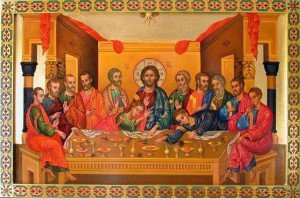After the congregation professes in God as Three-In-One and the priest in his priestly prayer likewise confirms this belief, the priest introduces the hymn which all present sing together with the angels in heaven. The prayer is the Holy, Holy, Holy. The priest introduces this prayer in this manner:
We thank You for this liturgy which You have willed to accept from our hands, even though there stand before You thousands of archangels, tens of thousands of angels, Cherubim and Seraphim, six-winged, many-eyed, soaring aloft on their wings, singing, shouting, crying out and saying the triumphal hymn:
That which immediately follows upon this priest introduction is the Hymn of Victory or Greek: ἐπινίκιος ὕμνος. It is taken originally from the Chalcedonian Christian Liturgy. This hymn is actually a combination of two events, Isaiah’s Heavenly Vision and the Triumphal Entry of Jesus into Jerusalem. In Isaiah 6:1b-4 we read about this vision:
I saw the Lord. He was sitting on a lofty throne, and the Temple was filled with his glory. Hovering about him were mighty, six-winged seraphs. With two of their wings they covered their faces; with two others they covered their feet and with two they flew. In a great antiphonal chorus they sang, “Holy, holy, holy is the Lord of Hosts; the whole earth is filled with his glory.”
This proclamation is also found in Revelation 4:8: “Day and night, without pause they sing: Holy, holy, holy is the Lord God Almighty, He who was, and who is and who is to come.”
Notice that John’s image was not of six-winged Seraphim, but of four living creatures. This is an interesting twist to the Isaiah imagery of the Heavenly Vision. John states previously what those four creatures were: In the center, around the throne, were four living creatures, and they were covered with eyes, in front and in back. The first living creature was like a lion, the second was like an ox, the third had a face like a man, the fourth was like a flying eagle. Irenaeus and Augustine both write that those four living creatures represented the Evangelists: Matthew, Mark, Luke and John. We see these icons of four living creatures on the Royal Doors in traditional Byzantine churches.
We proclaim this hymn together with the Heavenly Host. We believe that as we celebrate on earth, so too our celebration is connected with the same celebration in heaven. There is no separation between heaven and earth as we worship God.

